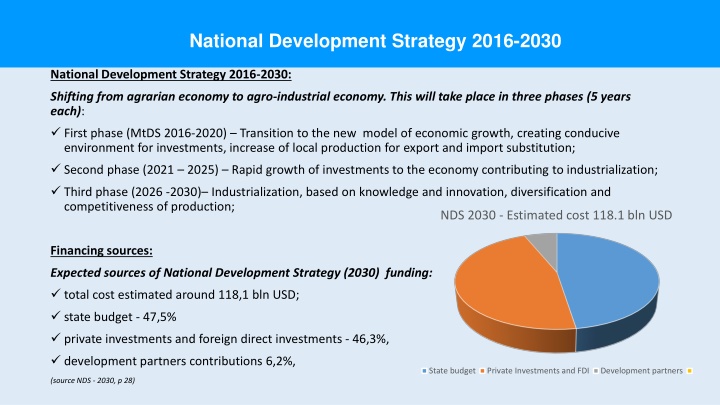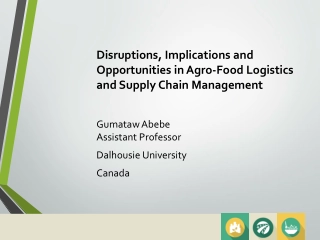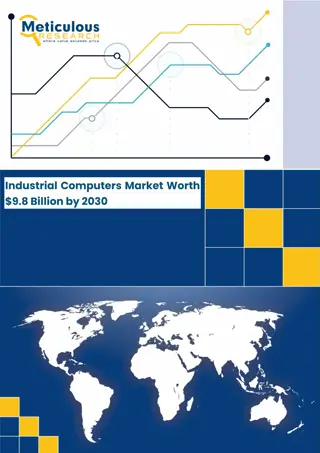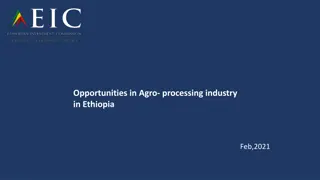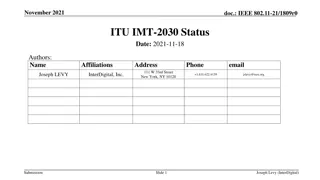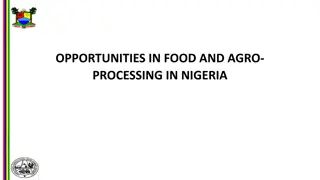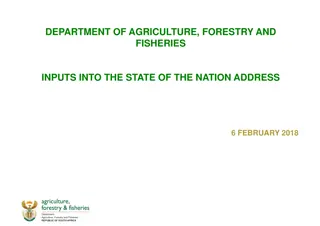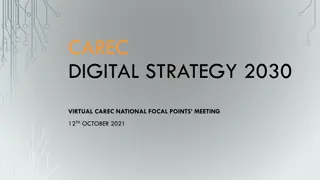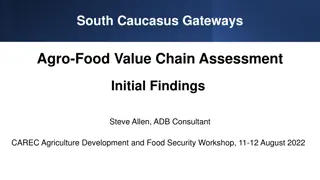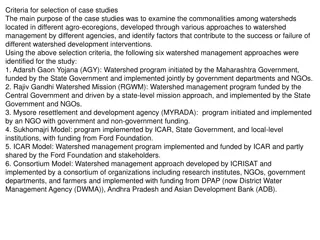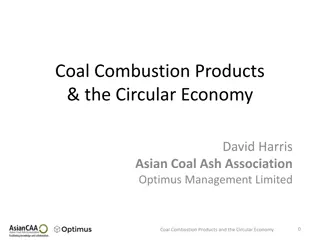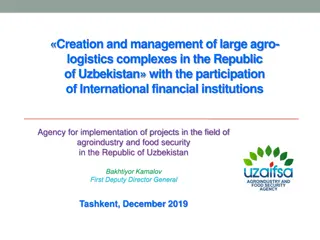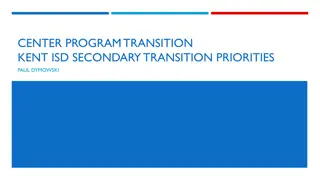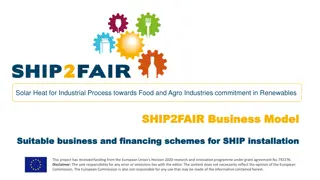National Development Strategy 2016-2030: Transition to Agro-Industrial Economy
Shifting from an agrarian economy to an agro-industrial economy through a phased approach over 2016-2030, focusing on economic growth, investment environment, industrialization, innovation, and competitiveness. The strategy emphasizes local production, export, import substitution, and knowledge-based industrialization.
Download Presentation

Please find below an Image/Link to download the presentation.
The content on the website is provided AS IS for your information and personal use only. It may not be sold, licensed, or shared on other websites without obtaining consent from the author.If you encounter any issues during the download, it is possible that the publisher has removed the file from their server.
You are allowed to download the files provided on this website for personal or commercial use, subject to the condition that they are used lawfully. All files are the property of their respective owners.
The content on the website is provided AS IS for your information and personal use only. It may not be sold, licensed, or shared on other websites without obtaining consent from the author.
E N D
Presentation Transcript
National Development Strategy 2016-2030 National Development Strategy 2016-2030: Shifting from agrarian economy to agro-industrial economy. This will take place in three phases (5 years each): First phase (MtDS 2016-2020) Transition to the new model of economic growth, creating conducive environment for investments, increase of local production for export and import substitution; Second phase (2021 2025) Rapid growth of investments to the economy contributing to industrialization; Third phase (2026 -2030) Industrialization, based on knowledge and innovation, diversification and competitiveness of production; NDS 2030 - Estimated cost 118.1 bln USD Financing sources: Expected sources of National Development Strategy (2030) funding: total cost estimated around 118,1 bln USD; state budget - 47,5% private investments and foreign direct investments - 46,3%, development partners contributions 6,2%, State budget Private Investments and FDI Development partners (source NDS - 2030, p 28)
Mid-term Development Strategy (2016-2020) Mid-term Development Strategy (2016-2020): Promoting new economic growth based on effective institutions; Attracting private sector investments in to the real sector of economy and infrastructure; Increasing production of export-oriented goods and services contributing to import substitution; Facilitate creation of productive employment; Financing sources: MtDS estimated 25 bln USD Expected sources of Mid term Development Strategy (2016 2020) funding: total cost estimated around 25.5 bln (USD) state budget 54 %, private sector - 36%, development partners - 10% State budget Private sector Development partners (Source MtDS (2016-2030), page 109)
Mid-term Development Strategy (2016-2020) 1. INSTITUTIONAL CAPACITY STRENGTHENING: Improving Public Administration Efficiency Business Environment and Investment Climate Improvement Public-Private Partnership (PPP) MID-TERM DEVELOPMENT STRATEGY OF RT FOR 2016-2020 (PRIORITIES) DCC CLUSTER AND EXISTED WGs CHAPTER II. INSTITUTIONAL CAPACITY STRENGTHENING DCC Cluster 5: Governance: Improving Public Administration Efficiency DCC WG 9 - Public Administration Reform 2.1. DCC WG 10 Rule of Law DCC Anti-Corruption WG (thematic) 2.2.Business Environment and Investment Climate Improvement DCC Cluster 6: Economic and Private Sector Development: WG 11 - Private and Financial Sector Development 2.3.Public-Private Partnership (PPP) DCC WG 11 - Private and Financial Sector Development
Mid-term Development Strategy (2016-2020) 2. IMPROVING EFFICIENCY AND DIVERSITY OF THE REAL SECTORS RESERVES , CAPACITY AND COMPETITIVENESS OF THE ECONOMY: Industry Agrarian Sector: Food Security and Access to Quality Nutrition Fuel and Energy Complex Transport and Communication Infrastructure Financial Sector External (Economic) Sector CHAPTER III. IMPROVING THE EFFICIENCY AND DIVERSITY OF THE REAL SECTORS RESERVES AND CAPACITY AND STRENGTHENING COMPETITIVENESS OF THE ECONOMY 3.1. Industry DCC Cluster 1- Natural Resources, Cluster 2 Food Security & Nutrition, Cluster 3 Infrastructure. DCC Cluster 6: Economic and Private Sector Development : WG 12 Regional Trade Facilitation? DCC Cluster 1: Natural Resources: DCC WG 1- Agriculture and Land DCC Cluster 2: Food Security & Nutrition 3.2. Agrarian Sector: Food Security and Access to Quality Nutrition 3.3. 3.4. 3.5. Fuel and Energy Complex Transport and Communication Infrastructure Financial Sector DCC WG 4 Energy DCC WG 5 Transport DCC Cluster 6: Economic and Private Sector Development: WG 11 3.6. External (Economic) Sector DCC WG 12 Regional Trade Facilitation
Mid-term Development Strategy (2016-2020) 3. HUMAN CAPITAL DEVELOPMENT AND IMPROVING THE QUALITY OF SOCIAL SERVICES: Demographic Change Management (population management) Productive Employment Education and Science Health and Longevity Social Protection Culture Human Habitat Reducing Social Inequality 4.5. CHAPTER IV. HUMAN CAPITAL DEVELOPMENT AND IMPROVING THE QUALITY OF SOCIAL SERVICES DCC Cluster 4: Human Development 4.1. (population management) Demographic Change Management DCC Cluster 4: Human Development DCC WG 6, 7, 8 4.2. Productive Employment 4.3. Education and Science DCC WG 7 - Education 4.4. Health and Longevity DCC WG 6 Health Social Protection DCC WG 8 Social Protection 4.7. Human Habitat DCC WG 2 Water and Climate Change 4.8. Reducing Social Inequality (Gender) DCC Cluster 4: DCC WG 8 Social Protection 6.2 Monitoring and evaluation system UNDP MTDS M&E and SDG - Presentation
